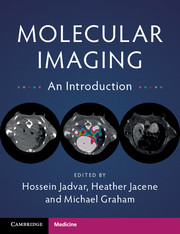Book contents
- Frontmatter
- Contents
- List of Contributors
- Preface
- 1 Instrumentation – CT
- 2 MRI/ MRS Instrumentation and Physics
- 3 Optical and Ultrasound Imaging
- 4 Instrumentation-Nuclear Medicine and PET
- 5 Quantitation-Nuclear Medicine
- 6 Perfusion
- 7 Metabolism
- 8 Cellular Proliferation
- 9 Hypoxia
- 10 Receptor Imaging
- 11 Apoptosis
- 12 Angiogenesis
- 13 Reporter Genes
- 14 Stem Cell Tracking
- 15 Amyloid Imaging
- Index
- References
3 - Optical and Ultrasound Imaging
Published online by Cambridge University Press: 22 November 2017
- Frontmatter
- Contents
- List of Contributors
- Preface
- 1 Instrumentation – CT
- 2 MRI/ MRS Instrumentation and Physics
- 3 Optical and Ultrasound Imaging
- 4 Instrumentation-Nuclear Medicine and PET
- 5 Quantitation-Nuclear Medicine
- 6 Perfusion
- 7 Metabolism
- 8 Cellular Proliferation
- 9 Hypoxia
- 10 Receptor Imaging
- 11 Apoptosis
- 12 Angiogenesis
- 13 Reporter Genes
- 14 Stem Cell Tracking
- 15 Amyloid Imaging
- Index
- References
Summary
Optical Imaging
Optical imaging has been used by countless species since the evolution of the eye. It is used as a critical observational technique in assessing the skin of patients by dermatologists. It is used for internal examination by endoscopists. However, following the invention of the microscope in the late 1500s, optical imaging began to be extended to much smaller objects. The capabilities of the microscope have evolved over the recent centuries, with many different approaches, such that it is impossible to fully review optical microscopy in a brief chapter. The major focus of this chapter is fluorescent and bioluminescent imaging in small animals, and when feasible in humans. A recent textbook that covers the subject area in greater depth is Biomedical Optical Imaging. The reader can also find an excellent review of general microscopy in Wikipedia and of optical microscopy at the Olympus Microscopy Research Center.
Fundamental Issues
As photons propagate through tissue, they are attenuated and scattered. The degree of attenuation and scattering depends on the wavelength of the light and the characteristics of the tissue being imaged. In most animals, including humans, a major determinate of the absorption of light is hemoglobin. Visible light extends from 380 nm (deep violet) to 750 nm (dark red). Hemoglobin absorbs markedly from about 500 nm to 600 nm, with significant difference in absorption between oxygenated and deoxygenated hemoglobin. Above 600 nm, extending into the near infrared, the absorption is much less, allowing penetration of photons to several millimeters or even centimeters. This illustrates why near infrared imaging is the favored part of the spectrum to use for in-vivo optical imaging.
Fluorescence Imaging
The essential elements of fluorescence imaging are: (1) existence of a fluorescent molecule within tissue that has localized there by bulk flow (i.e. blood vessels or lymphatics), binding to a receptor, or metabolic trapping; (2) illumination of the tissue with a light source of appropriate wavelength, which excites the fluorescent molecule; and (3) a detection system that can image the emitted light from the fluorescent molecule.
- Type
- Chapter
- Information
- Molecular ImagingAn Introduction, pp. 16 - 18Publisher: Cambridge University PressPrint publication year: 2017



